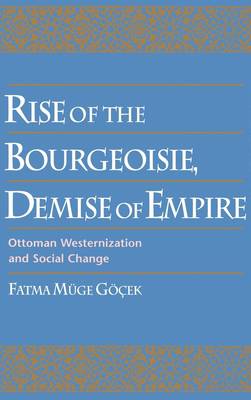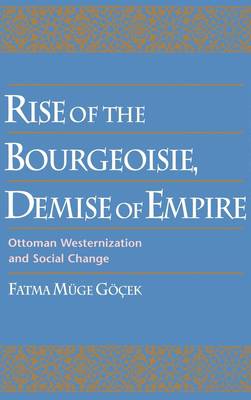
- Afhalen na 1 uur in een winkel met voorraad
- Gratis thuislevering in België vanaf € 30
- Ruim aanbod met 7 miljoen producten
- Afhalen na 1 uur in een winkel met voorraad
- Gratis thuislevering in België vanaf € 30
- Ruim aanbod met 7 miljoen producten
Zoeken
Rise of the Bourgeoisie, Demise of Empire
Ottoman Westernization and Social Change
Fatma Muge Gocek, Fatma M G Ek
Hardcover | Engels
€ 249,95
+ 499 punten
Omschrijving
What are the causes of imperial decline? This work studies the Ottoman empire in the 18th and 19th centuries to argue that the Ottoman imperial decline resulted from a combination of Ottoman internal dynamics with external influences. Specifically, it contends that the split within the Ottoman social structure across ethno-religious lines interacted with the effects of war and commerce with the West to produce a bifurcated Ottoman bourgeoisie. This bourgeoisie, divided into disparate commercial and bureaucratic elements, was able to challenge the sultan but was ultimately unable to salvage the empire. Instead, the Ottoman empire was replaced by the Turkish nation-state and others in the Balkans and the Middle East. This work will appeal to students of sociology and Ottoman studies.
Specificaties
Betrokkenen
- Auteur(s):
- Uitgeverij:
Inhoud
- Aantal bladzijden:
- 232
- Taal:
- Engels
Eigenschappen
- Productcode (EAN):
- 9780195099256
- Verschijningsdatum:
- 1/02/1996
- Uitvoering:
- Hardcover
- Formaat:
- Genaaid
- Afmetingen:
- 160 mm x 227 mm
- Gewicht:
- 489 g

Alleen bij Standaard Boekhandel
+ 499 punten op je klantenkaart van Standaard Boekhandel
Beoordelingen
We publiceren alleen reviews die voldoen aan de voorwaarden voor reviews. Bekijk onze voorwaarden voor reviews.











